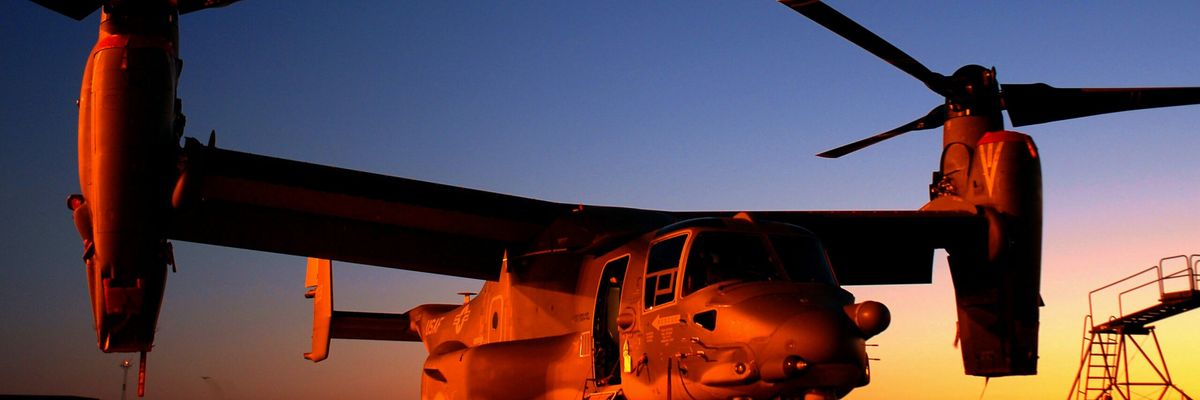Less than two weeks ago, service members, veterans, and their families gathered together to mark Memorial Day. Flags waved above solemn ceremonies as Americans of all walks of life took a moment to remember those who have died fighting for the United States around the world.
Since then, three military aircraft have gone down, leaving at least five service members dead and two injured. But these tragedies didn't happen over far-off battlefields. Instead, they came on routine training missions in Alabama and California.
This quick succession of crashes is rare, but deadly accidents involving U.S. military planes are anything but. In late 2020, Congress found that, in just six years, “mishaps” in training flights or routine missions killed 198 service members and civilians, destroyed 157 aircraft, and cost taxpayers $9.41 billion.
Two years after the congressional report, crashes are still happening with alarming frequency, leading many to wonder why this seemingly simple issue still plagues the world’s best-funded military. Experts who spoke with Responsible Statecraft had a simple answer: The epidemic of accidents is the result of a military budget geared more towards shiny, cutting-edge tech than the nuts and bolts of pilot safety.
“There's big lobbies for big ticket systems,” said Bill Hartung of the Quincy Institute, “and there’s not the same kind of lobby for aviation safety.”
In order to understand why these crashes keep happening, it’s helpful to look back at the 2020 congressional report. Investigators recommended a series of common sense moves to fix the problem, including increased money for maintenance and spare parts as well as establishing an oversight board for aviation safety at the Pentagon. They also suggested that crashes were happening because pilots were simply not flying often enough and recommended that they get more hours in.
Yet Dan Grazier, a defense expert at the Project on Government Oversight, says the Pentagon is “largely at the same place” as it was when the report came out. According to Defense One, an oversight board has still not been established. And Grazier notes that “in some cases, there’s been an effort to double down on some of the problems.”
Take, for example, the issue of flight hours. In 2021, active-duty pilots in the Air Force got an average of 10.1 flight hours per month, a slight decrease from the 10.9 flight hours they averaged in 2020. And Heritage Foundation senior defense fellow John Venable, himself a former F-16 pilot, recently said pilots are only getting about 4.1 hours per month. As suggested in the report, the Pentagon has tried to make up for the lack of time in the air by training pilots on simulators.
But Grazier says that simulator hours are not a real replacement for time in the air. He pointed to a 2020 incident in which an F-35 crashed during a landing at Eglin Air Force Base in Florida. According to Grazier, the pilot “had trained extensively on the simulator,” but this training didn’t prepare him for a glitch during landing. “The simulator acted in one way as the aircraft was landing, but then the real aircraft acted in a different way,” Grazier said.
Luckily, the pilot was able to eject, and no one was injured in the incident. But the problem remains clear: America has a stock of complex aircraft like the (more than a little controversial) F-35 that can’t get in the air as often as their simpler ancestors and are more likely to malfunction, sometimes in disastrous ways.
Just yesterday a Marine Corps MV-22 Osprey crashed in California, killing four Marines onboard. Since the aircraft’s inception, observers have argued that the Osprey has an unnecessarily complicated design, with a “tiltrotor” system that allows it to take off like a helicopter but fly like any large prop plane.
This science fiction design is too good to be true, according to Lawrence Korb of the Center for American Progress. “That darn thing should never have been bought,” Korb said.
“When that program was started, I was in the building, as they say, in the 80s,” he continued. “It was so expensive and [had] so many problems that the Army dropped out of it, and basically the Marines stayed in.”
The Osprey’s doubters have been proven right over the years as accidents have plagued the space-age aircraft, which has crashed eight times since 2007 and twice just this year, according to the San Diego Union Tribune.
So why does Congress keep ordering complex planes like the F-35 and the Osprey? According to Grazier, it’s a problem of priorities, which have been muddled by defense contractors that stand to make big money on aircraft that cost billions to build and maintain.
“Hardware is not a solution in and of itself,” Grazier said. “You need to have the right hardware to implement the good ideas so the good people can use it to go out and win wars.”
With Pentagon budget season in full swing, the problem of priorities has come into sharp relief. The recent crashes have already pushed lawmakers to add language in next year’s budget authorization that will force the DoD to do an annual report on the findings of the “joint aviation safety council” that it was instructed to create in 2020.
In prior years, some observers have blamed military budget cuts for avoidable crashes. But Grazier says it can’t be fixed by “throwing money at the problem.”
“The fact that we did throw so much money at the Pentagon [after 9/11] has actually contributed to this,” he said. Grazier likened the DoD’s relative blank check in the last 20 years to giving his teenage daughter his credit card and telling her to “have at it.”
“There would be a lot of really bad decisions made with that,” he said. “Whereas if I handed her $20 and [said] ‘Hey, make sure you spend this wisely because you’re not getting anything else,’ she’d make more prudent decisions.”
Instead of ogling at sleek new planes, Grazier says Congress needs to act as “disciplinarians,” asking the hard questions about the lifetime costs of expensive programs and keeping defense industry interests in check.
As Hartung notes, these structural problems will take years to address, even if Congress and the Pentagon get on board immediately. But there’s a lot that can be done in the meantime to make pilots safer.
“It wouldn't be rocket science to move more money to training and try to get the spare parts thing straightened out,” Hartung said. “It could be a multi-year undertaking, but I think there’s things that can be done now that would save lives that aren’t being done at the moment.”
- Military officials: 'widowmaker' Osprey will fly with a faulty clutch | Responsible Statecraft ›
- Disabled refueler exposes fragility of US mission in Middle East | Responsible Statecraft ›
- Military aircraft accidents are spiking | Responsible Statecraft ›
- Why do military planes keep crashing? | Responsible Statecraft ›
























